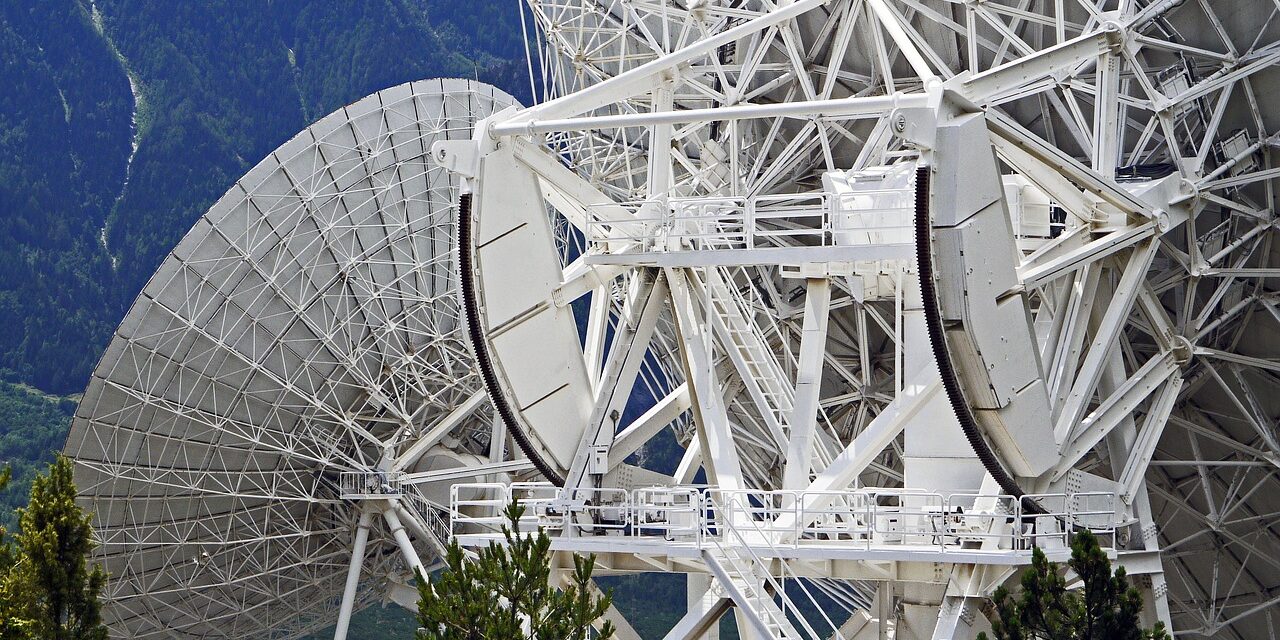China’s Five-hundred-meter Aperture Spherical radio Telescope (FAST) is the world’s largest single-dish radio telescope. Located in Pingtang County, Guizhou province, it began observations in September 2016. The FAST radio telescope is an important tool for astronomers and astrophysicists to study the universe and search for extraterrestrial life.
The FAST radio telescope has a diameter of 500 meters, and its dish is made up of 4,450 panels that can be adjusted to focus on different parts of the sky. It is capable of detecting weak radio signals from distant galaxies and black holes, and has already made several important discoveries since it began operating. The telescope is also expected to play a crucial role in the search for alien life, as it can detect signals from other planets that may be too weak for other telescopes to pick up.
Overall, the FAST radio telescope is a remarkable feat of engineering and an important tool for scientific research. Its large size and sensitivity make it an ideal instrument for studying the universe and searching for signs of extraterrestrial life.
History of the FAST Radio Telescope
Initial Proposal
The Five-hundred-meter Aperture Spherical Telescope (FAST) was first proposed in 1994 by Chinese astronomers. The project aimed to build a single-dish radio telescope with a large aperture and high sensitivity, capable of detecting weak signals from distant objects in the universe. The initial design of the telescope was based on the Arecibo Observatory in Puerto Rico, which was then the largest radio telescope in the world.
Construction Phase
After years of planning and fundraising, the construction of FAST began in 2011 in the Dawodang depression, Guizhou province, China. The project was approved by the National Development and Reform Commission (NDRC) in July 2007, and received a budget of 1.2 billion yuan (about 180 million US dollars) from the Chinese government. The construction of FAST was completed in September 2016, and the telescope was officially put into operation in January 2020.
The construction of FAST was a major engineering feat, involving the installation of thousands of panels on a hollowed-out karst basin. The telescope has a diameter of 500 meters, making it the largest single-dish radio telescope in the world. It is also highly sensitive, capable of detecting radio waves from objects as far as tens of billions of light-years away.
Operational Phase
Since its inauguration, FAST has been used for a variety of astronomical observations, including pulsar timing, hydrogen line mapping, and SETI (Search for Extraterrestrial Intelligence) research. In 2019, the telescope detected a repeating fast radio burst (FRB) for the first time, providing new insights into the nature of these mysterious cosmic signals.
FAST has also become a popular tourist attraction, drawing visitors from all over China and beyond. The telescope has a visitor center that offers guided tours and educational programs, as well as a hotel and a restaurant for visitors who want to stay overnight.
Overall, the construction and operation of FAST represent a major milestone in China’s efforts to become a leading player in the field of radio astronomy. With its large aperture, high sensitivity, and advanced technology, FAST is expected to make significant contributions to our understanding of the universe in the years to come.
Technical Specifications
Design
The Five-hundred-meter Aperture Spherical radio Telescope (FAST) is a Chinese mega-science project that aims to build a 500-meter diameter active reflector radio telescope in a karst depression in Guizhou province. The telescope’s design is based on an Arecibo-type antenna and features a large karst depression site that can accommodate the 500-meter telescope and a zenith angle of 40 degrees. The telescope’s active main reflector corrects for spherical aberration on the ground to achieve full polarization and a wide band without involving complex hardware.
Hardware
FAST has a 500-meter diameter but only 300 meters are “illuminated” at once. The telescope’s surface is composed of 4,450 panels, each measuring 11 meters by 9 meters. The panels are supported by a cable-net structure that is suspended over the depression. The telescope’s feed cabin is located at the focal point of the reflector and houses the receiver and the transmitter. The receiver is composed of a 19-beam receiver system that operates at frequencies ranging from 70 MHz to 3 GHz.
Software
FAST’s software system is composed of three main subsystems: the observation control system, the data management system, and the signal processing system. The observation control system is responsible for controlling the telescope’s movement and orientation, while the data management system is responsible for the storage and retrieval of observation data. The signal processing system is responsible for processing the raw data collected by the telescope into a usable format.
In summary, the FAST radio telescope is a remarkable feat of engineering that required innovative design, cutting-edge hardware, and sophisticated software. The telescope’s design is based on an Arecibo-type antenna and features a large karst depression site that can accommodate the 500-meter telescope and a zenith angle of 40 degrees. The telescope’s hardware includes a surface composed of 4,450 panels, each measuring 11 meters by 9 meters, and a 19-beam receiver system that operates at frequencies ranging from 70 MHz to 3 GHz. The telescope’s software system is composed of three main subsystems: the observation control system, the data management system, and the signal processing system.
Scientific Contributions
The Five-hundred-meter Aperture Spherical Radio Telescope (FAST) has made significant contributions to scientific research since its inception. Here are some of the most notable scientific achievements made possible by FAST:
Discovery of Pulsars
FAST has enabled the discovery of many new pulsars, which are highly magnetized, rotating neutron stars that emit beams of electromagnetic radiation. In 2019, FAST discovered a new pulsar, named J1859-01, which has a rotation period of 1.83 seconds and is located in the Milky Way galaxy. This discovery was made possible by the telescope’s high sensitivity and large collecting area.
Extraterrestrial Search
FAST has also been used to search for extraterrestrial intelligence. In 2020, FAST began a search for signals from intelligent life in the universe, known as the “Breakthrough Listen” project. This project is a collaboration between the SETI Institute and the Breakthrough Initiatives, and it aims to search for signals from alien civilizations in the Milky Way and nearby galaxies. Although no signals have been detected yet, the project is ongoing, and FAST is expected to play a crucial role in the search for extraterrestrial intelligence.
Study of Galactic Structure
FAST has also been used to study the structure of the Milky Way galaxy. In 2021, FAST was used to map the distribution of hydrogen gas in the Milky Way, which is crucial for understanding the structure and evolution of the galaxy. This study revealed new details about the spiral arms of the Milky Way and the distribution of hydrogen gas in the galaxy’s disk and halo.
Overall, FAST has made significant contributions to scientific research in the fields of astronomy and astrophysics. Its large collecting area and high sensitivity have enabled many new discoveries, and it is expected to continue to play a crucial role in scientific research for many years to come.
Challenges and Controversies
Relocation of Residents
The construction of the Five-hundred-meter Aperture Spherical Radio Telescope (FAST) in Guizhou province required the relocation of over 9,000 residents from the surrounding area. The Chinese government offered compensation to these residents, but some have criticized the relocation process as inadequate.
Some residents were unhappy with the compensation they received, stating that it was not enough to cover the cost of rebuilding their homes and businesses. Others were unhappy with the location of their new homes, which they claimed were far from their original communities and lacked basic amenities such as shops and schools.
Environmental Impact
The construction of the FAST telescope also raised concerns about its potential impact on the environment. The telescope is located in a karst landscape, which is known for its unique geological features such as sinkholes and underground drainage systems.
Environmentalists have expressed concern that the construction of the telescope may have damaged the karst landscape, which is a fragile ecosystem that supports a variety of plant and animal species. The construction process also required the removal of a large number of trees, which some have criticized as harmful to the local ecosystem.
To mitigate these concerns, the Chinese government has implemented a number of environmental protection measures around the telescope site. These measures include reforestation efforts and the establishment of a buffer zone around the telescope to limit human activity in the area.
Despite these efforts, some have criticized the government’s response as inadequate and have called for greater transparency and accountability in the management of the telescope and its impact on the environment.
Overall, the construction and operation of the FAST telescope has been a source of controversy and debate in China. While the telescope represents a major achievement in the field of astronomy, it has also raised important questions about the cost and impact of scientific progress on local communities and the environment.
Future Prospects
The FAST Radio Telescope has already made significant contributions to the field of radio astronomy, but its future prospects are even more exciting. Here are some potential future applications of the telescope:
- Detection of more Fast Radio Bursts (FRBs): FAST is expected to detect many more FRBs, which are brief, bright pulses of radio emission from distant galaxies. In 2021, FAST detected over 1,600 FRBs from a single source, which is a significant achievement. As more FRBs are detected, scientists can use them to study the intergalactic medium, the distribution of matter in the universe, and the properties of neutron stars and black holes.
- Search for extraterrestrial intelligence (SETI): FAST has the potential to search for signals from extraterrestrial civilizations. In fact, the telescope has already been used to search for signals from the nearby star Proxima Centauri, which has a potentially habitable planet. While the chances of detecting a signal from an intelligent civilization are low, the search is important for understanding the prevalence of life in the universe.
- Study of pulsars and gravitational waves: FAST can be used to study pulsars, which are rapidly rotating neutron stars that emit beams of radio waves. By studying pulsars, scientists can test Einstein’s theory of general relativity and detect gravitational waves, which are ripples in spacetime caused by the collision of massive objects. In fact, FAST has already detected several new pulsars, including one in a binary system.
- Mapping of the Milky Way and other galaxies: FAST can be used to map the distribution of gas and dust in the Milky Way and other galaxies. By studying the distribution of matter, scientists can learn about the formation and evolution of galaxies, as well as the nature of dark matter. In addition, FAST can be used to study the large-scale structure of the universe, including the distribution of galaxies and the properties of dark energy.
Overall, the future prospects for the FAST Radio Telescope are bright. With its enormous size and advanced technology, the telescope is poised to make many more groundbreaking discoveries in the coming years.
Frequently Asked Questions
Where is the largest radio telescope in the world located and what is it called?
The largest radio telescope in the world is located in China’s Guizhou province and is called the Five-hundred-meter Aperture Spherical Telescope (FAST).
What were the results of the Chinese radio telescope?
The Chinese radio telescope has detected more than 1,600 fast radio bursts from a single enigmatic system. In addition, it has helped scientists make important new scientific research achievements in 2021.
What is the most powerful radio telescope in the world?
The most powerful radio telescope in the world is the Five-hundred-meter Aperture Spherical Telescope (FAST) located in China’s Guizhou province.
Did China’s fast telescope find the largest atomic cloud ever discovered?
No, China’s fast telescope did not find the largest atomic cloud ever discovered. This is a false claim that has been circulating on social media.
What are some discoveries made by the Five-hundred-meter Aperture Spherical telescope?
The Five-hundred-meter Aperture Spherical Telescope (FAST) has made several discoveries, including the detection of interstellar molecules, leading the international very long baseline interferometry (VLBI) network, and pulsar observations.
Are there any images available from the Tianyan telescope?
Yes, there are images available from the Tianyan telescope. These images can be found on various websites and scientific publications.






